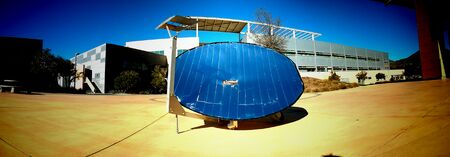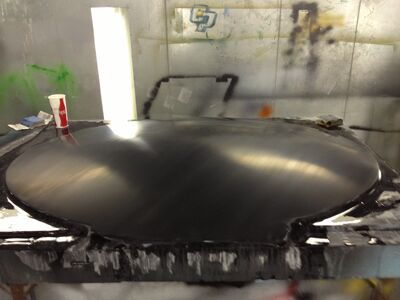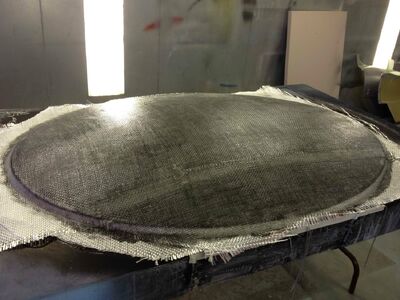(→Design) |
Tom Sponheim (talk | contribs) m (→External Links) |
||
| (18 intermediate revisions by 7 users not shown) | |||
| Line 1: | Line 1: | ||
| + | {{GoogleTranslateLinks}} |
||
| ⚫ | |||
| + | {{Updated|9|12|13}} |
||
| ⚫ | |||
| ⚫ | |||
| ⚫ | |||
==Design== |
==Design== |
||
The Cal Poly Scheffler Reflector was built from the design on http://www.solare-bruecke.org/ of a 2m<sup>2</sup> aluminium reflector.<sup>1</sup> |
The Cal Poly Scheffler Reflector was built from the design on http://www.solare-bruecke.org/ of a 2m<sup>2</sup> aluminium reflector.<sup>1</sup> |
||
| + | |||
| + | Work is currently being done on a new design using a fiberglass dish based on the principles of a deformable dish that tracks the sun with a fixed focus. Deformation of the dish will be accomplished using tensioned strings that run vertically and horizontally accross the sun-gathering side. |
||
==Parabolic Dish== |
==Parabolic Dish== |
||
| − | Typically, a parabolic dish is constructed with crossbars bent to their proper radii of curvature |
+ | Typically, a parabolic dish is constructed with metal crossbars bent to their proper radii of curvature individually and then mounted on an elliptical frame. This must be done carefully and with high attention to detail because the dish will not focus correctly if the crossbars are not exact. |
| + | |||
| − | ndividually and then mounted on an elliptical frame. This must be done carefully and with high attention to detail because the dish will not focus correctly if the crossbars are not exact. The team at Cal Poly is exploring alternative ways of constructing the parabolic dish. Currently they are building a fiberglass mold. |
||
| + | The team at Cal Poly is exploring alternative ways of constructing the parabolic dish. They have made a mold to make fiberglass dishes, and one dish has been made out of two layers of 2[[File:Photo_1.jpg|thumb|400px|The mold in its final stages of sanding]]4 ounce fiberglass cloth. |
||
| + | |||
| + | [[File:Cal_Poly_Solar_mold_with_fiberglass.jpg|thumb|400px|Our first fiberglass dish, still on the mold]] |
||
==Solar Tracking Device== |
==Solar Tracking Device== |
||
| + | A solar tracking device was successfully built by the Cal Poly team and implemented with the reflector. A circuit was set up to compare the light hitting two photoresistors separated by a divider, and to deliver voltage accordingly to a motor connected to the rotational chain of the reflector. The device is battery-operated. |
||
{{Main|Solar tracking}} |
{{Main|Solar tracking}} |
||
==Thermal Storage Unit== |
==Thermal Storage Unit== |
||
| + | |||
| ⚫ | |||
A thermal storage unit was designed and built in conjunction with the reflector in 2010. Materials used were concrete, rebar, and a square metal plate as cooking surface. Eleven wired thermistors were embedded into the poured concrete and labeled according to location. Eight are still connected externally. Although we were unable to know exactly where these thermistors were located due to concrete settling, they still allowed us to test the heat retention of the unit. They also gave us an idea of the temperatures reached. |
A thermal storage unit was designed and built in conjunction with the reflector in 2010. Materials used were concrete, rebar, and a square metal plate as cooking surface. Eleven wired thermistors were embedded into the poured concrete and labeled according to location. Eight are still connected externally. Although we were unable to know exactly where these thermistors were located due to concrete settling, they still allowed us to test the heat retention of the unit. They also gave us an idea of the temperatures reached. |
||
Testing of the unit is ongoing, but it is clear that our current unit is not reliable enough to integrate with the existing reflector. Designing a useful thermal storage unit is currently a secondary priority. |
Testing of the unit is ongoing, but it is clear that our current unit is not reliable enough to integrate with the existing reflector. Designing a useful thermal storage unit is currently a secondary priority. |
||
| ⚫ | |||
| + | |||
| + | ==See also== |
||
| + | *[[Pete Schwartz]] |
||
| + | *[[Scheffler Community Kitchen]] |
||
==External Links== |
==External Links== |
||
| − | + | *[http://www.solare-bruecke.org/Bauanleitungen/Bauanleitung-2qm-Schefflerkocher-deutsche-version-2010.pdf 2-square-meter Aluminum Scheffler Reflector] |
|
| − | + | *[http://digitalcommons.calpoly.edu/cgi/viewcontent.cgi?article=1023&context=physsp Construction and Improvement of a Scheffler Reflector and Thermal Storage Device, 2010] |
|
| + | |||
| + | ==Contact== |
||
| + | Cal Poly Solar Project<br /> |
||
| + | San Luis Obispo, {{State|California|CA}} |
||
| + | [[USA]] |
||
| + | |||
| + | Email: [mailto:cpsolar@googlegroups.com cpsolar@googlegroups.com] |
||
| + | |||
| + | Like us on Facebook: https://www.facebook.com/cpscheffler |
||
| + | [[Category:NGOs]] |
||
| + | [[Category:Educational institutions]] |
||
| + | [[Category:California]] |
||
| + | [[Category:USA]] |
||
| + | [[Category:Parabolic solar cooker designs]] |
||
Revision as of 17:47, 13 August 2014
|
Last edited: 12 September 2013
|
A research team at Cal Poly State University, San Luis Obispo is working to design a reliable Scheffler reflector. We aim to simplify the designs of the original Scheffler reflector for ease of construction and use.

Cal Poly Scheffler Reflector
Design
The Cal Poly Scheffler Reflector was built from the design on http://www.solare-bruecke.org/ of a 2m2 aluminium reflector.1
Work is currently being done on a new design using a fiberglass dish based on the principles of a deformable dish that tracks the sun with a fixed focus. Deformation of the dish will be accomplished using tensioned strings that run vertically and horizontally accross the sun-gathering side.
Parabolic Dish
Typically, a parabolic dish is constructed with metal crossbars bent to their proper radii of curvature individually and then mounted on an elliptical frame. This must be done carefully and with high attention to detail because the dish will not focus correctly if the crossbars are not exact.
The team at Cal Poly is exploring alternative ways of constructing the parabolic dish. They have made a mold to make fiberglass dishes, and one dish has been made out of two layers of 2

The mold in its final stages of sanding
4 ounce fiberglass cloth.

Our first fiberglass dish, still on the mold
Solar Tracking Device
A solar tracking device was successfully built by the Cal Poly team and implemented with the reflector. A circuit was set up to compare the light hitting two photoresistors separated by a divider, and to deliver voltage accordingly to a motor connected to the rotational chain of the reflector. The device is battery-operated.
- Main article: Solar tracking
Thermal Storage Unit
A thermal storage unit was designed and built in conjunction with the reflector in 2010. Materials used were concrete, rebar, and a square metal plate as cooking surface. Eleven wired thermistors were embedded into the poured concrete and labeled according to location. Eight are still connected externally. Although we were unable to know exactly where these thermistors were located due to concrete settling, they still allowed us to test the heat retention of the unit. They also gave us an idea of the temperatures reached.
Testing of the unit is ongoing, but it is clear that our current unit is not reliable enough to integrate with the existing reflector. Designing a useful thermal storage unit is currently a secondary priority.
- Main article: Thermal storage
See also
External Links
- 2-square-meter Aluminum Scheffler Reflector
- Construction and Improvement of a Scheffler Reflector and Thermal Storage Device, 2010
Contact
Cal Poly Solar Project
San Luis Obispo, California
USA
Email: cpsolar@googlegroups.com
Like us on Facebook: https://www.facebook.com/cpscheffler
